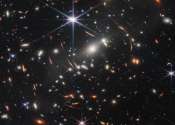Astronomers spot distant galaxy group driving ancient cosmic makeover
An international team of astronomers funded in part by NASA has found the farthest galaxy group identified to date. Called EGS77, the trio of galaxies dates to a time when the universe was only 680 million years old, or less ...









